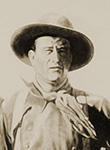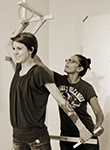Each spring Blackbird’s Introductions Reading Loop recognizes writers whose work strikes us as unusually fine and full of promise. Joining this company are poets Michael Bazzett, Oliver Bendorf, Rodney Gomez, Sally Wen Mao, and L.S. McKee, and fiction writers Adrienne Celt, Douglas Silver, and Emily Williamson. These writers demonstrate yet again that our best art is, thankfully, a renewable resource.
The First Novelist Reading Loop presents Ramona Ausubel’s No One Is Here Except All of Us, winner of the 2013 Cabell First Novelist Award. The novel introduces us to a world made new, a village grappling with the idea of language and the way it imprints on reality “again and again, across the face of the earth.” The Reading Loop includes panelists discussing the book’s journey from idea to publication, a reading from the novel, and a conversation with Ramona Ausubel.
In Poetry, Amy Arthur stoically observes, in “Cast Net,” a father and daughter at once separated and united by the tools they use, the words they exchange. Melissa Barrett offers a haunted rendering
of nightfall near a lakeside cabin: “the water peeling toward us like spoons.” Melissa Ginsburg’s sparse assemblages offer slice-of-life glimpses of what it means to walk armed and dangerous into a hunter’s blind, onto a shooting range. Her speaker’s threat, “I am the heart of my weapon,” is also promise.
In translations of Catullus by Len Krisak, the long-dead interlocutor dishes: “there’s nothing dumber than a dumb-ass grin,” said of Egnatius who smiled equally at tears or funeral rites. Andrew Kozma’s characters, more soberingly, recall days of plague, of burying “men / so wrapped in flowers their heads were lion-maned.”
Circe Maia, in six poems translated by Jesse Lee Kercheval, writes of the “shock of not being able to lie down / or lean against anything / because / it gives way.” And of grief, of a familiar question spoken by the person lost which “is inaudible now but can almost be heard / . . . in the twilight zone / between reality and remembrance.”
Tom Sleigh’s sectioned poem “KM4” is set in KM4 Mogadishu. Ten paintings by Michael Hafftka extend the imaginative space, providing, as Hafftka writes, “another view of the same event.” In the poem, an AK-47 speaks; it “wants to tell . . . / a truth ungarbled that is so obvious / that no one could possibly mistake its meaning.”
In Fiction, Michael McGriff and J.M. Tyree embark on a call-and-response exercise, creating a series of interwoven fictional sketches rooted in classic films. The six sketches provide a brief glimpse into their forthcoming book, Our Secret Life in the Movies.
Kimberly N. Frank’s “Jersey Shore” recreates a primal desperation in her main character, Ruby, in a journey driven by rhythm and sound. Her quest spirals in on itself as the narrative plunges inward to self-reflection and outward to the desire for meaning: “You want to hear a story like that.”
C. Dale Young gives us a community unsettled by prophecy and despair, where the traditional structures we often lean on, family and future, shake apart into something temporal, tenuous. Elise Levine’s “On Floating Bodies” takes that same kind of chaotic breakdown as its guiding principle, weaving through a clouded, broken world that offers her narrator only brief moments of insight, all in the hope of piecing together a darting, dynamic narrative.
In Nonfiction, man’s best friend is rendered unforgettable by the howl Walter Bennett sends up in “Jake,” an essay praising his beloved canine alter ego. The Llewellyn setter’s companionship guides the author toward the realization that peaceful coexistence is “not about bargaining for freedom and privileges,” but rather “about knowing the point where you will not bargain at all, knowing what is bred in the bone, imprinted on the soul.” (Dogs also appear, more than usual, in the poems of this issue—Ralph Hamilton’s mythically wagging beast, sporting “the color of redemption & revenge”; Jen Hirt’s ferocious, fern-destroying poodle, with his “disobedient perm” and “ratty chinfur”; Liam O’Brien’s fantastically planetary mutt decked out in “his cape of joy,” his “plumage” of “snow and chutney.”)
Also in Nonfiction, a pair of formally textured personal essays by Julie Marie Wade exude surprising, fresh perspectives from which to view familiar territories—coming of age, coming to terms with the connectedness and the alienation that shapes us as individuals.
In a tribute to Louis D. Rubin Jr. and his years at Hollins College, Robert Rubin offers a heartfelt perspective that touches on the roots of what fostered his father’s particular gifts in scholarship and shepherding young writers.
The Chapbook Omnibus Review by Emilia Phillips brings together reviews of new work by poets Aubrey Lenahan, Philip Metres, Matthew Minicucci, Michele Poulos, and Steve Scafidi. Phillips sounds the creative dimensions of the chapbook form and offers her own pragmatic insights into its evolving potential.
Craig Beaven’s review of Phillips’s new volume, Signaletics, also appears here, along with reviews of poetry by Ron Smith and novels by Ramona Ausubel, Elaine Neil Orr, and Virginia Pye. Susan Settlemyre Williams looks at the “new, galloping voice” demonstrated in Ellen Bryant Voigt’s most recent collection of poems, Headwaters.
In Gallery, a selection from Kelly Younger’s play, This World We Know, puts side by side the complicated interactions of siblings in their twenties with those of the same siblings in their sixties. The play is scheduled to debut at Richmond’s Firehouse Theatre on February 5, 2015.
Tom Condon’s Idiopathic Aura showed at the Visual Arts Center of Richmond; the photographs explore the artist’s experience with temporary blindness and include images of braille treated with wax and metallic powder to create otherworldly landscapes and horizons.
Recently performed at the University of Alabama, Birmingham, George Ferrandi’s The Prosthetics of Joy is a multi-media one-act play based on a group photograph of children. Ferrandi employs student, staff, and faculty to stage the leaping exuberance of the children, incorporating custom-built “prosthetics” to position the players; the performance culminates in a second photograph, mirroring the original.
Bernard Martin’s Stagecoach: The Paintings showed at Richmond’s former Gallery A. Each of the large paintings replicates one of twenty-four individual frames from one second of the iconic John Wayne film, Stagecoach. In addition, the paintings appear in our pages as a looping animation.
Continuing our publication of work from the digital archives, Blackbird presents Charles Sheeler and Paul Strand’s film, Manhatta; we pair it here with Robert Allerton Parker’s 1921 review of the film, “The Art of the Camera: An Experimental Movie.” Parker speculates on the future of photography and film, writing that “in the hands of such craftsmen the camera becomes truly an instrument of great art.”
Finally, in Features, look for the Reading Loops which head this foreword, a conversation with novelist Kevin Powers (The Yellow Birds), a conversation with poet Tom Sleigh, and a Poetics Principles reading at the Library of Virginia by Charles Wright and Ellen Bryant Voigt. ![]()
Return to top menus | Browse issue













